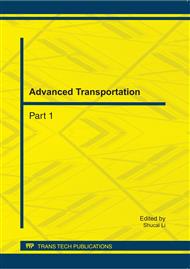p.386
p.391
p.397
p.402
p.408
p.414
p.418
p.425
p.429
The Material and Mechanical Property of Heavy-Duty Prestressed Concrete Sleeper
Abstract:
This study is focused on the heavy duty sleeper using steel fiber reinforced concrete (SFRC) material to substitute wooden material and on the analysis of the performance of such sleeper. The purpose is mainly to develop heavy-duty prestressed concrete sleeper (HPCS) with high strength and good ductility, and to meet the needs of heavy load for the railroad engineering. The results show that all the properties of designed SFRC conform to design requirement and by using pozzolanic materials, steel fiber and low water content as well as cement content can increase strength, toughness and durability of concrete. The ultimate flexural load of HPCS is 3 times higher than wooden sleeper (WS), and after 3,000,000 cycles repeat loading it shows no failure. This implies that HPCS has better service life than WS and can reduce life cycle cost as replace WS.
Info:
Periodical:
Pages:
408-413
Citation:
Online since:
September 2011
Price:
Сopyright:
© 2011 Trans Tech Publications Ltd. All Rights Reserved
Share:
Citation:


